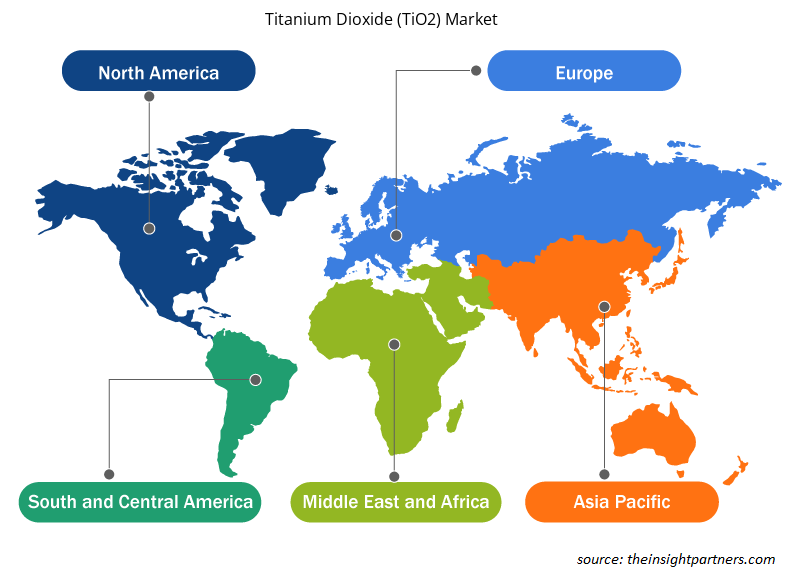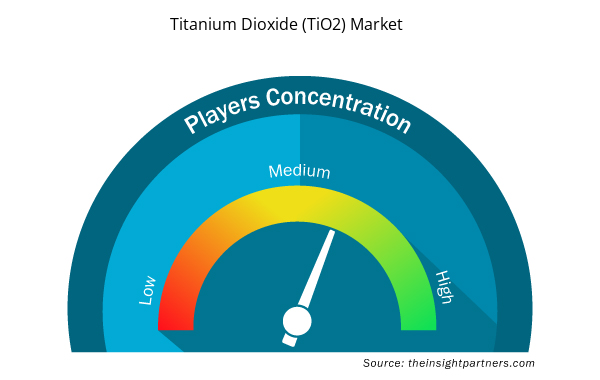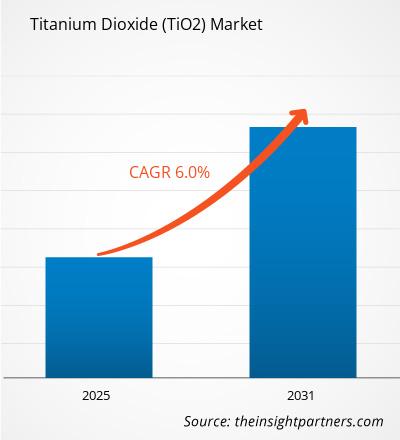Der Markt für Titandioxid wird voraussichtlich von 2024 bis 2031 eine durchschnittliche jährliche Wachstumsrate (CAGR) von 6 % verzeichnen, wobei die Marktgröße von XX Millionen US-Dollar im Jahr 2024 auf XX Millionen US-Dollar bis 2031 wachsen wird.
Der Titandioxid-Marktbericht ist nach Qualität (Anatas, Rutil und andere) segmentiert. Der Markt ist nach Verfahren segmentiert (Sulfat und Chlorid). Der Markt ist nach Anwendung segmentiert (Farben und Beschichtungen, Kunststoffe, Papier, Tinten, Lebensmittel, Klebstoffe, Kosmetika und andere). Die Marktgröße und -prognose auf globaler, regionaler und Länderebene für alle wichtigen Marktsegmente werden im Rahmen des Berichts abgedeckt. Der Bericht bietet den Wert in USD für die oben genannte Analyse, Segmente, Regionen und Länder. Der Bericht deckt Markttrends sowie Marktdynamiken wie Treiber, Beschränkungen und wichtige Chancen ab. Der Bericht deckt auch die Branchenlandschaft und Wettbewerbsanalyse ab, einschließlich Marktkonzentration, Heatmap-Analyse, prominenter Akteure und jüngster Entwicklungen auf dem Markt.
Zweck des Berichts
Der Bericht „Titandioxidmarkt“ von The Insight Partners soll die aktuelle Situation und das zukünftige Wachstum sowie die wichtigsten treibenden Faktoren, Herausforderungen und Chancen beschreiben. Dies wird verschiedenen Geschäftspartnern Einblicke geben, wie zum Beispiel:
- Technologieanbieter/-hersteller: Um die sich entwickelnde Marktdynamik zu verstehen und die potenziellen Wachstumschancen zu kennen, damit sie fundierte strategische Entscheidungen treffen können.
- Investoren: Durchführung einer umfassenden Trendanalyse hinsichtlich der Marktwachstumsrate, der finanziellen Marktprognosen und der Chancen entlang der Wertschöpfungskette.
- Regulierungsbehörden: Zur Regulierung von Richtlinien und Überwachungsaktivitäten auf dem Markt mit dem Ziel, Missbrauch zu minimieren, das Vertrauen der Anleger zu bewahren und die Integrität und Stabilität des Marktes aufrechtzuerhalten.
Titandioxid Marktsegmentierung
Grad
- Anatas
- Rutil
Verfahren
- Sulfat und Chlorid
Anwendung
- Farben und Lacke
- Kunststoffe
- Papier
- Tinten
- Essen
- Klebstoffe
- Kosmetika
Geographie
- Nordamerika
- Europa
- Asien-Pazifik
- Süd- und Mittelamerika
- Naher Osten und Afrika
Passen Sie diesen Bericht Ihren Anforderungen an
Sie erhalten kostenlos individuelle Anpassungen an jedem Bericht, einschließlich Teilen dieses Berichts oder einer Analyse auf Länderebene, eines Excel-Datenpakets sowie tolle Angebote und Rabatte für Start-ups und Universitäten.
- Holen Sie sich die wichtigsten Markttrends aus diesem Bericht.Dieses KOSTENLOSE Beispiel umfasst eine Datenanalyse von Markttrends bis hin zu Schätzungen und Prognosen.
Wachstumstreiber auf dem Titandioxidmarkt
- Growth in Demand for TiO? in Paints and Coatings: Titanium dioxide (TiO?) is predominantly used as a white pigment in paints, coatings, and other decorative products because of its excellent opacity, brightness, and UV resistance. The construction and automobile industries specifically have considerably increased demand for paints and coatings containing TiO?. These industries grow directly with the booming construction industry in emerging economies and the continued high demand for coatings in automobile production.
- TiO?'s Role in the Plastics Industry: The most common application of titanium dioxide is in the plastic industry where it is used in the filling of materials such as PVC, polypropylene, and polyethylene produced opaque and bright materials. Besides, TiO? has increasingly turned out to be an ingredient that cannot be avoided in packaging applications, prolonging the lifetime and resistance to ultraviolet light of plastic products. Consumer goods, food companies, and pharmaceuticals stranglehold and further drive the demand for plastic packaging. The production of high quality and long lasting packaging materials depends heavily on TiO?. Subsequently, TiO? is always in demand.
- Expanding Use in Personal Care and Cosmetics: Titanium dioxide is a significant ingredient found in personal care as well as cosmetic products, primarily those concerning sunscreen, lotion, and make-up, attributable to its good properties toward UV blocking. Hence, as the world becomes aware of the importance of sun-protective measures and that the skin stays healthy, so the demand for TiO? products is expanding into different segments in the personal care sector. Alongside that, the increasing popularity of natural and organic beauty products, with many using TiO? often in their formulations as a mineral sunscreen, is also driving the market, especially in developed parts of the world.
Titanium Dioxide Market Future Trends
- Growing Demand for Nano-TiO? in Cosmetics, Sunscreens, and Self-Cleaning Surfaces: The most promising future prospect of the titanium dioxide market is the increasing use of nano-sized TiO?. The most efficient UV-blocker, with better photocatalytic activity and good transparency, is Nano-TiO? for several application areas such as cosmetics, sunscreens, and self-cleaning surfaces. Nano-TiO2 has been a topic of interest among researchers with modern advances in production technology. This is expected to boost the growth of nano-Tio2 in several industries as end-users increasingly seek high-performing materials, hence developing specialized opportunities.
- Shift Towards Sustainable and Greener TiO? Production Technologies: The global economies push toward developing more innovative and sustainable processes for producing TiO?. The conventional routes normally employed in the production of titanium dioxide-the high-energy chloride route and sulfuric acid route-cause major environmental impacts. More and more often, attention is increasingly being directed towards the development of "greener" technologies, which include the use of alternative raw materials or clean production processes reducing emissions and waste. This is expected to increase as both industries and consumers demand more sustainability from their supply chain partners.
- Rising Demand for High-Performance TiO? in Specialty Applications: Currently, there is an inclination toward high-performance TiO? for specialty applications as industries become more demanding in their materials. The trend is that of the automotive industry, for example, where there is a swing toward high-performance coatings, using even high-performance TiO?, to ensure better durability and color retention. In addition to these, TiO? is also being put to photocatalytic applications for environmental cleanup purposes and water treatment. Such innovative applications spurred on by technological advances wear the stamp of increased demand in specialty-grade titanium dioxide.
Titanium Dioxide Market Opportunities
- Emerging Markets Driving Titanium Dioxide Demand in Paints, Coatings, and Plastics: That is fast upcoming markets where titanium dioxide is making rapid strides due to emerging country demand in paints, coatings, and plastics. Potential for urbanization and infrastructure development is among the number of opportunities that are available, particularly in China, India, Brazil, and Nigeria. These days, consumers show more interest in personal care and consumer goods at home as they earn fairly disposable incomes.
- Titanium Dioxide's Role in Renewable Energy and Smart Building Solutions: Titanium dioxide is opening fresh avenues in renewable energy applications right from photocatalysis. This has several avenues, including solar cells, hydrogen production, and energy-efficient self-cleaning surfaces used in buildings. This new offering of product diversification into renewable energy technologies is therefore becoming the growing thrust for sustainable energy solutions and smart buildings.
- Advancements in TiO? Production Technologies Unlocking New Market Opportunities: For example, advances in production technologies always promise more rhinoceroses in terms of cheaper, more cost-effective manufacturing methodologies, perhaps with improved production technologies. Existing production methods can be optimized or entirely new methods can be adapted, which can reduce costs and improve performance. The breakthroughs in tiny and smaller nano and micro-sized TiO? could bring booming applications in electronics, automotive, and medical fields. Such alteration signifies a potential opportunity for new growth by enabling manufacturers to cater specialty products to niche and high-margin markets.
Titanium Dioxide (TiO2) Market Regional Insights
The regional trends and factors influencing the Titanium Dioxide (TiO2) Market throughout the forecast period have been thoroughly explained by the analysts at Insight Partners. This section also discusses Titanium Dioxide (TiO2) Market segments and geography across North America, Europe, Asia Pacific, Middle East and Africa, and South and Central America.

- Get the Regional Specific Data for Titanium Dioxide (TiO2) Market
Titanium Dioxide (TiO2) Market Report Scope
| Report Attribute | Details |
|---|---|
| Market size in 2024 | US$ XX million |
| Market Size by 2031 | US$ XX Million |
| Global CAGR (2025 - 2031) | 6% |
| Historical Data | 2021-2023 |
| Forecast period | 2025-2031 |
| Segments Covered | By Grade
|
| Regions and Countries Covered | North America
|
| Market leaders and key company profiles |
|
Titanium Dioxide (TiO2) Market Players Density: Understanding Its Impact on Business Dynamics
The Titanium Dioxide (TiO2) Market market is growing rapidly, driven by increasing end-user demand due to factors such as evolving consumer preferences, technological advancements, and greater awareness of the product's benefits. As demand rises, businesses are expanding their offerings, innovating to meet consumer needs, and capitalizing on emerging trends, which further fuels market growth.
Market players density refers to the distribution of firms or companies operating within a particular market or industry. It indicates how many competitors (market players) are present in a given market space relative to its size or total market value.
Major Companies operating in the Titanium Dioxide (TiO2) Market are:
- Anhui Annada Titanium Industry Co., Ltd.
- Argex Titanium, Inc.
- Cristal Global
- Evonik Industries AG
- Huntsman Corporation
Disclaimer: The companies listed above are not ranked in any particular order.

- Überblick über die wichtigsten Akteure auf dem Titandioxid (TiO2)-Markt
Wichtige Verkaufsargumente
- Umfassende Abdeckung: Der Bericht deckt die Analyse von Produkten, Dienstleistungen, Typen und Endbenutzern des Titandioxid-Marktes umfassend ab und bietet einen ganzheitlichen Überblick.
- Expertenanalyse: Der Bericht basiert auf dem umfassenden Verständnis von Branchenexperten und Analysten.
- Aktuelle Informationen: Der Bericht stellt durch die Abdeckung aktueller Informationen und Datentrends Geschäftsrelevanz sicher.
- Anpassungsoptionen: Dieser Bericht kann angepasst werden, um spezifische Kundenanforderungen zu erfüllen und die Geschäftsstrategien optimal anzupassen.
Der Forschungsbericht zum Titandioxidmarkt kann daher dabei helfen, die Branchensituation und Wachstumsaussichten zu entschlüsseln und zu verstehen. Obwohl es einige berechtigte Bedenken geben kann, überwiegen die allgemeinen Vorteile dieses Berichts tendenziell die Nachteile.
- Historische Analyse (2 Jahre), Basisjahr, Prognose (7 Jahre) mit CAGR
- PEST- und SWOT-Analyse
- Marktgröße Wert/Volumen – Global, Regional, Land
- Branche und Wettbewerbsumfeld
- Excel-Datensatz

Report Coverage
Revenue forecast, Company Analysis, Industry landscape, Growth factors, and Trends

Segment Covered
This text is related
to segments covered.

Regional Scope
North America, Europe, Asia Pacific, Middle East & Africa, South & Central America

Country Scope
This text is related
to country scope.
Häufig gestellte Fragen
Development of nano-titanium dioxide are expected to be the key market trends.
Based on geography, Asia Pacific held the largest share of the titanium dioxide market due to the strong growth of the paints, coatings, and plastics industries in the region.
Based on application, the paints and coatings segment is expected to witness the fastest growth during the forecast period.
Increasing demand for paints and coatings are driving the market growth.
Huntsman International LLC, Evonik, TAYCA Co Ltd, The Chemours Company, Tronox Holdings Plc, Kronos Worldwide Inc, INEOS, Showa America Inc, Foodchem International Corporation, and Shanghai Jiuta Chemical Co Ltd are the key players operating in the titanium dioxide market.
The Titanium Dioxide Market is estimated to witness a CAGR of 6% from 2023 to 2031
Trends and growth analysis reports related to Chemicals and Materials : READ MORE..
The List of Companies
- Anhui Annada Titanium Industry Co., Ltd.
- Argex Titanium, Inc.
- Cristal Global
- Evonik Industries AG
- Huntsman Corporation
- NL Industries, Inc.
- Tayca Corporation
- The Chemours Company
- Tronox Limited
- Venator Materials Corporation
The Insight Partners performs research in 4 major stages: Data Collection & Secondary Research, Primary Research, Data Analysis and Data Triangulation & Final Review.
- Data Collection and Secondary Research:
As a market research and consulting firm operating from a decade, we have published and advised several client across the globe. First step for any study will start with an assessment of currently available data and insights from existing reports. Further, historical and current market information is collected from Investor Presentations, Annual Reports, SEC Filings, etc., and other information related to company’s performance and market positioning are gathered from Paid Databases (Factiva, Hoovers, and Reuters) and various other publications available in public domain.
Several associations trade associates, technical forums, institutes, societies and organization are accessed to gain technical as well as market related insights through their publications such as research papers, blogs and press releases related to the studies are referred to get cues about the market. Further, white papers, journals, magazines, and other news articles published in last 3 years are scrutinized and analyzed to understand the current market trends.
- Primary Research:
The primarily interview analysis comprise of data obtained from industry participants interview and answers to survey questions gathered by in-house primary team.
For primary research, interviews are conducted with industry experts/CEOs/Marketing Managers/VPs/Subject Matter Experts from both demand and supply side to get a 360-degree view of the market. The primary team conducts several interviews based on the complexity of the markets to understand the various market trends and dynamics which makes research more credible and precise.
A typical research interview fulfils the following functions:
- Provides first-hand information on the market size, market trends, growth trends, competitive landscape, and outlook
- Validates and strengthens in-house secondary research findings
- Develops the analysis team’s expertise and market understanding
Primary research involves email interactions and telephone interviews for each market, category, segment, and sub-segment across geographies. The participants who typically take part in such a process include, but are not limited to:
- Industry participants: VPs, business development managers, market intelligence managers and national sales managers
- Outside experts: Valuation experts, research analysts and key opinion leaders specializing in the electronics and semiconductor industry.
Below is the breakup of our primary respondents by company, designation, and region:

Once we receive the confirmation from primary research sources or primary respondents, we finalize the base year market estimation and forecast the data as per the macroeconomic and microeconomic factors assessed during data collection.
- Data Analysis:
Once data is validated through both secondary as well as primary respondents, we finalize the market estimations by hypothesis formulation and factor analysis at regional and country level.
- Macro-Economic Factor Analysis:
We analyse macroeconomic indicators such the gross domestic product (GDP), increase in the demand for goods and services across industries, technological advancement, regional economic growth, governmental policies, the influence of COVID-19, PEST analysis, and other aspects. This analysis aids in setting benchmarks for various nations/regions and approximating market splits. Additionally, the general trend of the aforementioned components aid in determining the market's development possibilities.
- Country Level Data:
Various factors that are especially aligned to the country are taken into account to determine the market size for a certain area and country, including the presence of vendors, such as headquarters and offices, the country's GDP, demand patterns, and industry growth. To comprehend the market dynamics for the nation, a number of growth variables, inhibitors, application areas, and current market trends are researched. The aforementioned elements aid in determining the country's overall market's growth potential.
- Company Profile:
The “Table of Contents” is formulated by listing and analyzing more than 25 - 30 companies operating in the market ecosystem across geographies. However, we profile only 10 companies as a standard practice in our syndicate reports. These 10 companies comprise leading, emerging, and regional players. Nonetheless, our analysis is not restricted to the 10 listed companies, we also analyze other companies present in the market to develop a holistic view and understand the prevailing trends. The “Company Profiles” section in the report covers key facts, business description, products & services, financial information, SWOT analysis, and key developments. The financial information presented is extracted from the annual reports and official documents of the publicly listed companies. Upon collecting the information for the sections of respective companies, we verify them via various primary sources and then compile the data in respective company profiles. The company level information helps us in deriving the base number as well as in forecasting the market size.
- Developing Base Number:
Aggregation of sales statistics (2020-2022) and macro-economic factor, and other secondary and primary research insights are utilized to arrive at base number and related market shares for 2022. The data gaps are identified in this step and relevant market data is analyzed, collected from paid primary interviews or databases. On finalizing the base year market size, forecasts are developed on the basis of macro-economic, industry and market growth factors and company level analysis.
- Data Triangulation and Final Review:
The market findings and base year market size calculations are validated from supply as well as demand side. Demand side validations are based on macro-economic factor analysis and benchmarks for respective regions and countries. In case of supply side validations, revenues of major companies are estimated (in case not available) based on industry benchmark, approximate number of employees, product portfolio, and primary interviews revenues are gathered. Further revenue from target product/service segment is assessed to avoid overshooting of market statistics. In case of heavy deviations between supply and demand side values, all thes steps are repeated to achieve synchronization.
We follow an iterative model, wherein we share our research findings with Subject Matter Experts (SME’s) and Key Opinion Leaders (KOLs) until consensus view of the market is not formulated – this model negates any drastic deviation in the opinions of experts. Only validated and universally acceptable research findings are quoted in our reports.
We have important check points that we use to validate our research findings – which we call – data triangulation, where we validate the information, we generate from secondary sources with primary interviews and then we re-validate with our internal data bases and Subject matter experts. This comprehensive model enables us to deliver high quality, reliable data in shortest possible time.




 Get Free Sample For
Get Free Sample For